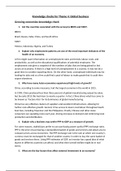Knowledge checks for Theme 4: Global business
Growing economies knowledge check
1. List the countries associated with the acronyms BRICS and MINT.
BRICS:
Brazil, Russia, India, China, and South Africa
MINT:
Mexico, Indonesia, Nigeria, and Turkey
2. Explain why employment patterns are one of the most important indicators of the
health of an economy.
A firm might want information on unemployment rates and trends, labour costs, and
productivity, as well as the educational qualifications of potential employees. The
employment rate gives a snapshot of the numbers of jobs that are being gained or lost
across an economy. If there is a high level of unemployment in a country, it may not be a
good time to consider exporting there. On the other hand, unemployed individuals may be
looking for jobs and so a firm could find a pool of labour to make goods that it could then
export elsewhere.
3. Why have many Asian economies experienced high levels of growth?
China, according to some measures, had the largest economy in the world in 2015.
In 1990, China produced less than three percent of global manufacturing output by value,
but by early 2015 this had risen to nearly a quarter. In fact, China drives what has come to
be known as ‘Factory Asia’ for its dominance of global manufacturing.
China has very effective clusters of suppliers and excellent infrastructure, allowing for
further cost-effective growth. Second, it has access to lower-cost labour throughout South
East Asia, including Myanmar and the Philippines. Finally, Chinese and other Asian
consumers are spending more each year, driving increases in demand and reinforcing local
production and distribution.
4. Explain why a business may prefer PPP to GDP as a measure of growth.
For some reasons, statisticians prefer to use purchasing power parity (PPP) exchange rates.
PPP is the price of purchasing a standardised basket of goods and services and allows you to
compare prices across economies. The PPP exchange rate is the rate at which one country’s
currency must be exchanged for that of another country in order to buy the same basket of
goods and services there. Using PPP estimates of GDP, an investor has a good idea of what
buyers in different countries can afford, and what their overall welfare might be in real
terms.
5. What are the key factors that affect external investment in an economy?
, Interest rates (the cost of borrowing)
Economic growth (changes in demand)
Confidence/expectations
Technological developments (productivity of capital)
Availability of finance from banks.
Others (depreciation, wage costs, inflation, government policy)
6. What does the Human Development Index (HDI) indicate about an economy?
Life expectancy
Mean years of schooling
Gross national income per capita (GNI)
, International trade and business growth knowledge check
1. Why do some countries try to limit imports?
Many countries try to limit the importation of goods by placing trade barriers in the way.
These barriers often involve tariffs, which are taxes that are imposed on imports. Trade
liberalisation, through hundreds of treaties as well as through monitoring by the World
Trade Organisation, has reduced the use of tariffs or limited the levels of tariffs that can be
levied.
2. What are the risks of being involved in exporting and importing?
If exchange rates move the wrong way between the currency of the exporter and that of the
importer, the consequences can be financially very serious. Also, governments can impose
barriers to imports that limit a firm’s access to the market. There may be conflicts with
agents or distributors that are difficult to resolve from outside the country.
3. What is meant by comparative advantage?
The theory that a country should specialise in products and services that it can produce
more efficiently than other countries.
4. How does specialisation lead to greater efficiency?
Specialisation in production, whereby a business focuses on a limited scope of products or
services, results in greater efficiency, allowing for goods and services to be produced at a
lower cost per unit. This in turn allows for businesses to reduce prices or to increase profit
margins, both of which can lead to business growth.
5. Explain what is meant by foreign direct investment.
Investing by setting up operations or buying assets in businesses in another country.
6. What are the different forms of foreign direct investment?
A joint venture
Strategic alliances
Buying through cross-border mergers and acquisitions





